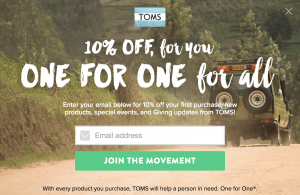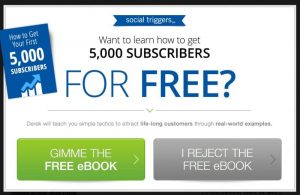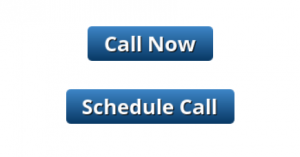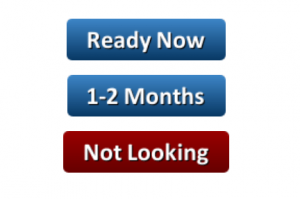Calls-to-Action (CTAs): Breaking Email’s Golden Rule
One aspect of marketing, which fascinates me involves what I call “interaction psychology.” How and why someone engages or doesn’t engage with content consumes much of my campaign prep work. This mental noodling led me to examine how I’m using Calls-to-Action (CTAs) in email programs.
Email’s CTA Golden Rule
A long-standing rule of email is to use one CTA only. Many blogs have been written about this subject. The thought behind one CTA per email stems from providing the recipient with just one simple decision to click – therefore making an engagement decision easier. Only one button to choose from means a better chance of a CTA clicks. The least amount of mental brainpower needed to act is preferred—sound advice for sure.
Below is an example of providing one CTA. Toms wants you to press the green “Join the Movement” button.

Rethinking the CTA Rule
Over the past couple of years, I’ve come to morph my thoughts on one CTA per email. It all started when I noticed web page exit intent pop-ups displaying two positive and negative choices. The only way to get rid of the pesky pop-up is to select an answer – yes or no. A “yes” click typically gets you to subscribe to something or get more awesome content, and a “no” click confirms you don’t want the goodness that comes with getting a subscription or more helpful content.
Notice in the example below from a marketing website on its free ebook offer. That’s a nicely worded take-away and makes the person clicking on it admit wanting a negative outcome.

These types of pop-ups got me thinking about how this approach relates to email campaign efforts. What if I could offer up related CTAs – each putting the other in context? Could engagement be affected by having one positive choice and one negative choice? Could the psychology of losing out on something affect decisions? Certainly, this is what exit intent pop-ups are designed to do. I had a new mission.
Behind My CTAs
My psychological hypothesis of using multiple and related CTAs centers around how people make choices. If I ask you a question like, “Do you want to go to the movies tonight?” you have a simple yes or no choice to make. The same is true when offering up one CTA. You are asking someone to click on a button or don’t click on a button. However, if I ask you, “Do you want to go see a movie, go to dinner or go to a comedy show tonight?” the likelihood of you choosing the fourth option – declining all suggestions – is less obvious. And hopefully less likely too.
My first attempt at multiple and related CTAs was in a post-secondary school open house invite. I added related CTAs with one as a positive and one as a negative. The two choices looked something like this:
![]()
![]()
The CTA “Give My Spot Away” infers the recipient owns the spot until forfeited. You have something and can give it away if you like. Having both options gives some context and value to the open house offer. Like the “no thanks, I don’t want free traffic” link mentioned earlier, the second CTA in my email offers up a conscious choice to part with something. Even if the open house spot is free, who wants to give something they already have? The psychology of decision-making in action.
To my delight, engagement did go up with two CTA open-house emails. I received more click-throughs than in previous emails with a “Save My Spot” only CTA. The two CTA emails produced both positive and negative engagements. The engagement went up even if the amount of positive engagement did not. Either way, getting engagement is better than not getting engagement—a small and important win.
CTAs for Now, Later, or Never
As a former salesperson, my mission was always to push leads into one of three buckets – Now, Later, or Never. Having too many leads in an “Unknown” bucket gives way to missing monthly sales goals, chasing unqualified leads, and using less-than-desired sales tactics. I’ve left my fair share of voicemail messages riddled with desperation. Please call me back. It will get my sales manager off my back.
When I knew which “buy bucket” leads fell into, I knew exactly which follow-up strategy to deploy. “Nows” were closed immediately, “Laters” were given regular communication edging them closer to becoming “Nows,” and “Nevers” were pushed aside so more attention could be given to leads that were at the very least – “close-able.”
Lately, I’ve been experimenting with other multiple and related CTAs arrangements. The CTAs in Examples 1 and 2 are included in a campaign for a client with heavy industry competition. Speed to lead is paramount because leads are purchased through an affiliate, a third-party lead generator selling leads to multiple and usually competing companies. The campaign needs to get as many leads as possible into the three buy buckets quickly.
Example 1: Talk now or talk later. This CTA combo has a 2.6% click-through rate against 2.2% for this industry, according to Constant Contact:
EX. 1

Example 2: A true Now, Later, Never CTA combination. The email pushes leads to reveal employment readiness. 35% of the leads who opened this email clicked a link.
Ex. 2

Example 3: Included in a campaign for a service industry client with aging potential clients holding unsigned proposals. After an offer to reduce the proposal price by 15%, the CTAs are constructed to easily let the lead tell our client how to move forward. According to Constant Contact, the CTA strategy emails are yielding a 12.9 % open-to-click-through rate against 11.8% for this industry.
Ex. 3
![]()
![]()
![]()
More Results: 39% of the clicks came from the green button. 51% of the clicks came from the yellow and red buttons. Half the clicks are telling the client there will not be an immediate sale. However, prospects have revealed how best to move forward with communication. Green (the “Now”) responses go to the sales team for immediate follow-up. Yellow responses (the “Laters”) are placed into a regular nurture campaign. Red (in this B2C case, the “Much Laters”) is placed into a nurture campaign with less delivery frequency.
CTAs for Everyone
I feel an email marketer’s job is to get engagement, even if that engagement doesn’t lead to a sale. As I’m writing the last sentence, I realize that may sound counterproductive to an agency/client relationship. The goal is engagement. A CTA click is always a win. Especially when the click helps reveals whether a lead is a Now, Later, or Never/Much Later.
When leads reveal themselves, it’s a win for the client. Knowing what follow-up strategy to use is a win for the agency as engagement tracking can be used to adjust lead gen efforts – allowing campaign optimization to leads who buy products and services from our clients, not just leads who inquire about them: a win and a win.
As with Colling Media’s Test, Analyze, and Test (TAO) methodology, one can end up having endless CTA pieces to test – total CTA buttons, colors, wording, order, etc. Anyway, breaking the Golden Rule email marketing – one CTA per email – helps clients get more leads to reveal themselves.
If you’re curious about “interaction psychology,” I recommend experimenting with CTAs in your emails and seeing what happens with engagement. Maybe it’s the CTA you’ve been looking for.
Colling Media is a Phoenix-based full-service advertising agency providing email marketing and marketing automation services.
Photo by Hans Gustafsson on Unsplash
